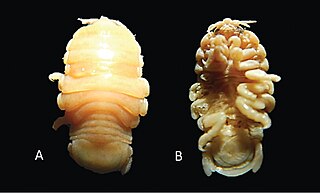
Tube-dwelling anemones or ceriantharians look very similar to sea anemones but belong to an entirely different class of anthozoans. They are solitary, living buried in soft sediments. Tube anemones live inside and can withdraw into tubes, which are composed of a fibrous material made from secreted mucus and threads of nematocyst-like organelles known as ptychocysts. Within the tubes of these ceriantharians, more than one polyp is present, which is an exceptional trait because species that create tube systems usually contain only one polyp per tube. Ceriantharians were formerly classified in the taxon Ceriantipatharia along with the black corals but have since been moved to their own class, Ceriantharia.

Sphaeromatidae is a family of isopods, often encountered on rocky shores and in shelf waters in temperate zones. The family includes almost 100 genera and 619 known marine species. Within these genera, there are groups that share distinctive morphologies; further research may reclassify these genus-groups as separate families.

Neverita lewisii, common name Lewis's moon snail, is a species of large operculated sea snail. It is a predatory marine gastropod in the family Naticidae, the moon snails. Traditionally, this species was assigned to either the genus Lunatia, the genus Polinices or the genus Euspira. Recently, it was assigned to the genus Neverita based on molecular data.

The Idoteidae are a family of isopod crustaceans. It includes these genera:

The Cirolanidae are a family of isopod crustaceans, including these genera:

Bastilla is a genus of moths in the family Erebidae. The genus was described by Swinhoe in 1918.

Endeostigmata is a suborder of acariform mites. There are about ten families in Endeostigmata. The grouping is strongly suspected to be paraphyletic, containing unrelated early diverging lineages of mites.

Cirolana is a genus of isopod crustaceans.
Colopisthus canna is a species of crustacean isopods of the family Cirolanidae that lives in Cape Verde. The species was described in 2003 by W. Moore and R. C. Brusca, based on individuals collected on São Vicente. São Vicente is the only known place where it occurs.

Triacanthella is a genus of springtails in the family Hypogastruridae. There are at least 20 described species in Triacanthella.

Xenylla is a genus of springtails and allies in the family Hypogastruridae. There are at least 120 described species in Xenylla.
Cestocampa is a genus of two-pronged bristletails in the family Campodeidae. There are at least four described species in Cestocampa.
Eumesocampa is a genus of two-pronged bristletails in the family Campodeidae. There are at least two described species in Eumesocampa.

Excirolana is a genus of isopods in the family Cirolanidae. There are about 15 described species in Excirolana.

Ptenothrix is a genus of globular springtails in the family Dicyrtomidae. There are about 11 described species in Ptenothrix.
Parallocampa is a genus of two-pronged bristletails in the family Campodeidae. There are at least two described species in Parallocampa.

Elthusa is a genus of isopods in the family Cymothoidae, with 40 described species.

Ceratothoais a genus of isopod ectoparasites of teleost fish, first described by James Dwight Dana in 1852. Infection by Ceratothoa can cause anaemia, lesions, growth retardation, emaciation, and mortality in their fish hosts.
Tridentella is a genus of crustaceans belonging to the monotypic family Tridentellidae.

Rocinela is a genus of isopods in the family Aegidae, and was first described in 1818 by William Elford Leach. The type species is Rocinela danmoniensis Leach, 1818.














